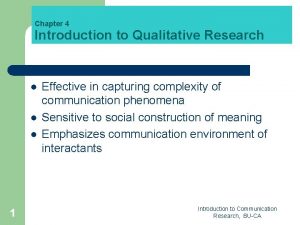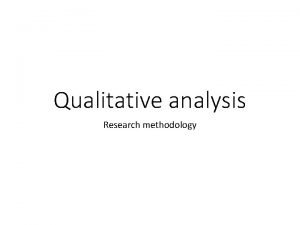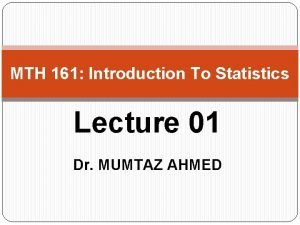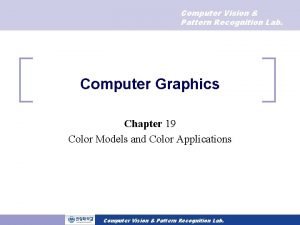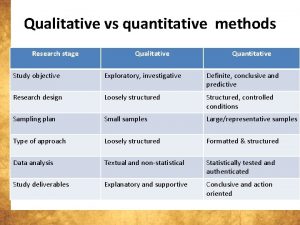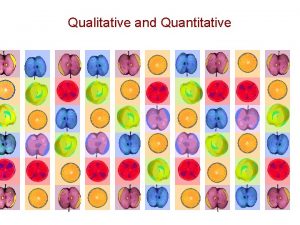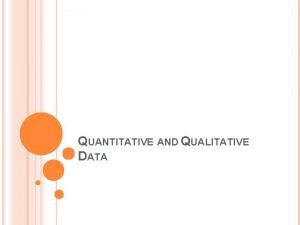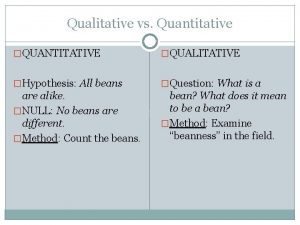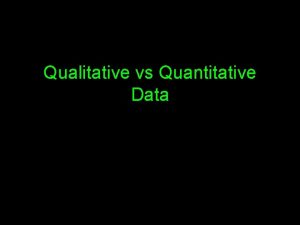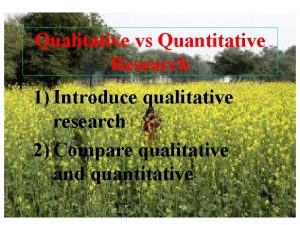Qualitative and Quantitative Research Contents of This Chapter



















- Slides: 19

Qualitative and Quantitative Research 李天行 輔仁大學管理學研究所

Contents of This Chapter £ Qualitative vs Quantitative Methods £ Assumptions for Quantitative Analysis £ Characteristics of Qualitative Research £ Qualitative Research Methodologies

Qualitative vs Quantitative Methods(1/7) £ Managers do business research to understand how and why things happen. £ If the manager needs to know only what happened, or how often things happened, quantitative research methods (量化研究) serve the purposes. £ On the other hand, if he/she plans to understand the different meanings that people place on their experiences often requires research techniques that delve more deeply into people’s hidden interpretation, understandings, and motivations. Under this kind of circumstances, qualitative research methods (質化研究) is the preferred choice.



Qualitative vs Quantitative Methods(4/7) £ Differences between qualitative and quantitative research methods: l Focus of research: Understand interpret vs Describe, explain, and predict l Research purpose: In-depth understanding: theory building vs Describe or predict; build and test theory l Researcher involvement: High-researcher is participant vs Limited; controlled to prevent bias l Sampling design: Nonprobability vs probability l Sample size: Small vs Large (除非是大規模及長時間的質化 研究)

Qualitative vs Quantitative Methods(5/7) £ Differences between qualitative and quantitative research methods: l Research design: May evolve or adjust during the course of project vs Often determined before commencing the project; Often uses multiple tools simultaneously or sequentially vs Uses single method or mixed methods; Consistency is not expected vs Consistency is crucial; Usually involves longitudinal approach vs Involves either a cross-sectional or a longitudinal approach l Particular preparation: Pretasking is common vs No preparation desired to avoid biasing the participant

Qualitative vs Quantitative Methods(6/7) £ Differences between qualitative and quantitative research methods: l Data type and preparation: Verbal or pictorial descriptions vs Verbal descriptions; Reduced to verbal codes with computer assistance vs Reduced to numerical codes for computerized analysis l Data analysis: Human analysis following computer coding, primarily nonquantitative vs Computerized analysis, primarily statistical or mathematical methods dominate l Insights and Meaning: Deeper level of understanding is the norm, determined by type and quantity of free-response questions vs Limited by the opportunity to probe responds and the quality of the original data collection instrument

Qualitative vs Quantitative Methods(7/7) £ Differences between qualitative and quantitative research methods: l Research sponsor involvement: May participate by observing research in real time or via taped interviews vs Rarely has either direct or indirect contact with participant l Feedback turnaround: Smaller sample sizes make data collection faster for short possible turnaround vs Large sample sizes lengthen data collection (internet methodologies could shorten turnaround but are inappropriate for many studies due to the fact of sampling bias); Insights are developed as the research progresses, shortening data analysis vs Insight development follows data collection and entry, lengthening research process

Assumptions for Quantitative Analysis £ Sufficient quantitative information is available (請注意 sufficient 之意). £ This information can be quantified in the form of numerical data (由於電腦及資料分析 具無法處理文 字型之資料). £ We have to assume that some or even the majority of the aspects of the pattern, trend, or relationship contained in the sample can be generalized into the whole population (如果無法確認這一點,則可能無法使用量化分析以 解決問題).

Quantitative and Qualitative Analysis £ Quantitative analysis: Sufficient quantitative information is available (Statistical, time series and other appropriate methods). £ Qualitative analysis: Little or no quantitative information is available, but enough qualitative knowledge exists (Interviews, focus groups, Delphi or even Jury opinion). £ Unpredictable or even hard to study: Little or no information is available (Predict the effect of living on MARS).



Characteristics of Qualitative Research (1/2) £ Qualitative research methods draws data or evidence from a variety of sources, including : l People (individuals or groups); l Organizations or institutions; l Texts (published, including virtual ones); l Settings and environments (visual/sensory and virtual material); l Objects, artifacts, media products (texture/visual/sensory and virtual material); l Events and happenings (texture/visual/sensory and virtual material).

Characteristics of Qualitative Research (2/2) £ Qualitative research methods involve nonprobability sampling, where little attempt is made to generate a representative sample. Several types of nonprobability sampling are common: l Purposive sampling: Researchers choose participants arbitrarily for their unique characteristics or their experiences, attitudes, or perceptions; as conceptual or theoretical categories of participants develop during the interviewing process, researchers seek new participants to challenge emerging patterns. l Snowball sampling. l Convenience sampling.

Qualitative Research Methodologies (1/4) £ Interviews (訪談)-可以概分為 individual depth interviews and group interviews 兩大類,訪談的方式又因屬性之不 同,可以分成 l Unstructured interviews (非結構性的訪談)-no specific questions or order of topics to be discussed. l Structured interviews (結構性的訪談)-often uses a detailed interview guide similar to a questionnaire to guide the question order and the specific way the questions are asked.

Qualitative Research Methodologies (2/4) £ Focus group (焦點群體) is a commonly adopted methodology in which a panel of people led by a trained moderator, who meet for 90 minutes or two hours. £ The facilitator or moderator uses group dynamics principles to focus or guide the group in an exchange of ideas, feelings, and experiences on a specific topic. £ Focus groups are often unique in research due to the research sponsor’s involvement in the process. Most facilities permit the sponsor to observe the group and its dynamics in real time, drawing his or her own insights from the conversations and nonverbal signals he or she observes.

Qualitative Research Methodologies (3/4) £ Grounded Theory (紮根理論) uses a structured interview, each subsequent interview is adjusted based on the findings and interpretations from each previous interview, with the purpose to develop general concepts or theories with which to analyze the data.

Qualitative Research Methodologies (4/4) £ Case study (個案研究), also refers to as the case history, is a powerful research methodology that combines individual and (sometimes) group interviews with record analysis and observation. Researchers extract information from company brochures, annual reports, sales records, and even newspapers and magazine articles, along with direct observation (usually done in the participants’ natural setting), and combine it with interview data from participants. The objective is to obtain multiple perspectives of a single organization, situation, event, or process at a point in time or even a period of time. £ The written report from a case study project, often called a case analysis or case write-up, can be used to understand particular marketing processes.
 Kind of quantitative research
Kind of quantitative research Qualitative and quantitative variables
Qualitative and quantitative variables Similarities between qualitative and quantitative research
Similarities between qualitative and quantitative research Similarities between qualitative and quantitative research
Similarities between qualitative and quantitative research Sampling methods in qualitative and quantitative research
Sampling methods in qualitative and quantitative research Examples of qualitative research
Examples of qualitative research Data analysis in research example qualitative
Data analysis in research example qualitative Quantitative vs qualitative experiment
Quantitative vs qualitative experiment Difference between qualitative and quantitative data
Difference between qualitative and quantitative data Qualitative vs quantitative observations
Qualitative vs quantitative observations Quantitative and qualitative difference
Quantitative and qualitative difference Ordinal variable example
Ordinal variable example Qualitative vs quantitative data analysis
Qualitative vs quantitative data analysis Types of quantitative variables
Types of quantitative variables Qualitative tests for lipids
Qualitative tests for lipids Examples of qualitative and quantitative observations
Examples of qualitative and quantitative observations Qualitative and quantitative physical properties
Qualitative and quantitative physical properties Qualitative and quantitative difference
Qualitative and quantitative difference Qualitative and quantitative difference
Qualitative and quantitative difference Hypothesis template
Hypothesis template



